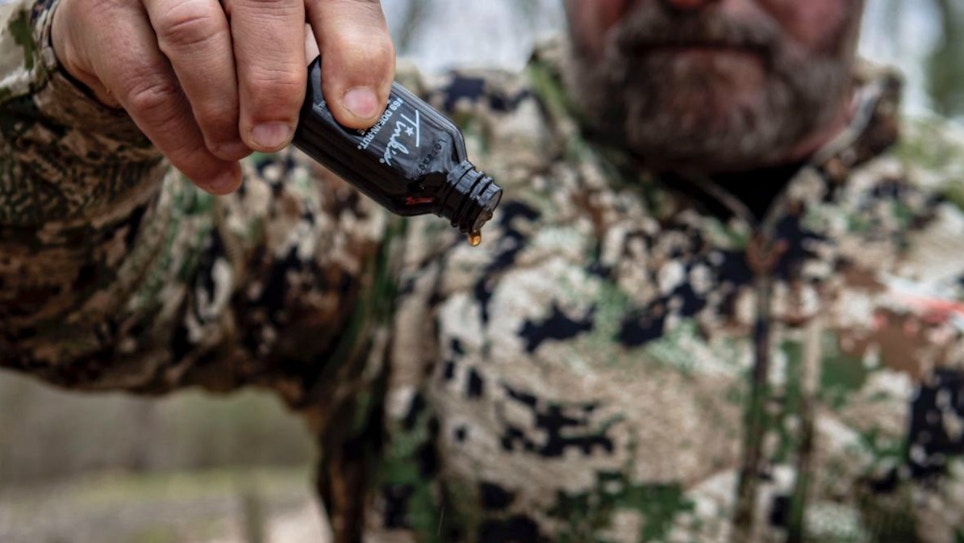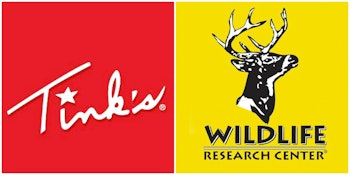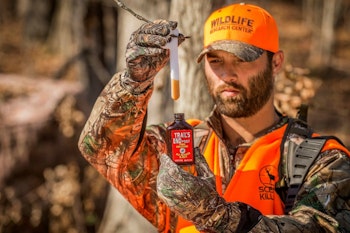The text below (unedited) was submitted to Whitetail Journal by representatives for two well-known companies that sell urine-based scents, Tink’s and Wildlife Research Center. Keep in mind that state officials often play “follow the leader” when it comes to complex issues such as this one, so if keeping urine-based scents legal is important to you, then the time to act is now.
The first letter is directed toward deer hunters in South Carolina. Following this text is a letter for deer hunters in Minnesota and Pennsylvania.
August 2019; South Carolina Deer Hunters:
The South Carolina Department of Natural Resources (DNR) released a new hunting rule last week banning urine-based scents, taking away an important hunting tool used by many successful hunters every year.
Unfortunately, there is a lot of false and misleading information driving policy and regulations regarding urine-based scents being a risk for spreading CWD. The impact of banning these products on hunters and businesses, both small and large across the state this year will be huge.
In the recent press release by the South Carolina DNR, it was stated “CWD research conducted in Colorado showed that mule deer were able to be infected with CWD after exposure to just the urine, feces and saliva of infected deer.” This statement is misleading and misrepresents the actual scientific finding of these studies. Many studies have attempted to transmit CWD with urine and none have been successful in deer. Later studies in Colorado used urine from CWD sick deer, concentrated it ten-fold, and injected it directly into brains of mice that were genetically altered to be 6 times more susceptible to the disease than deer. One of the nine mice became infected. We are led to believe that urine is a risk for spreading the disease by putting a small amount, from facilities that are enrolled in a program to safeguard their deer from risk of contamination, on a scent wick or squirting it on the ground when only one mouse became infected by injecting infected and concentrated urine into its brain? Hunters are not injecting deer with urine and the urine is coming from healthy animals and not sick ones!
Moreover, the urine collection process prevents or removes nearly all contamination from feces or saliva. Based on the study referenced and other available research, it is estimated to take close to 2 ounces of pure infected saliva from a single sick deer entirely ingested by one single deer to invoke an infection. Even with the larger 4-ounce bottles, we would have to believe that half of this bottle is pure saliva, and that the saliva was infected in the first place. Then we would have to believe that a single deer would drink the whole bottle. This is ridiculous to even be a consideration.
The urine from hunting scent companies like Wildlife Research Center and Tink’s is collected from healthy animals and not sick ones. South Carolina wildlife officials say that the urine comes from captive herd facilities and that CWD has been found in 40 captive cervid facilities since 2012. What they don’t tell you is the collection facilities that companies like Wildlife Research Center and Tink’s use are from a small number (less than a dozen) of highly specialized facilities and are vastly different than the other likely 10,000 deer farms across the country. Of the 40 mentioned positives since 2012, only 16 were in a certified herd testing and certification program, and none of those were closed to importation of deer like the facilities where urine is sourced. The facilities the urine scent companies utilize are all 100-percent monitored, meaning every deer that dies is tested. CWD has never been found in one of these urine collection facilities.
South Carolina wildlife officials also say the scent industry is not regulated by any agency or entity and there is no testing or marking requirements identifying the source of the urine products. That is also false. The collection facilities are regulated by state and federal department of agriculture and wildlife agency rules and regulations relating specifically to CWD and to the operation of those facilities. All of the source herds are 100-percent monitored. The department of agriculture requires that testing is conducted before issuing the testing certifications the facilities all have and maintain.
Furthermore, the scent industry with the help of the Archery Trade Association, worked with industry experts, wildlife disease experts, CWD scientists, and many others to develop the ATA Deer Protection Program to safeguard their facilities from any risk of CWD contamination. The small number of elite operations in this program far exceed the USDA standards with a higher level of biosecurity than any other of the previously mentioned deer farms and their products proudly display the ATA checkmark on their packaging. To name a few requirements of the program, the facilities have to be 100% monitored, closed to importation of deer, and are annually inspected by accredited veterinarians which also review their records to verify they are meeting all of the requirements of the program. According to two of the top experts who authored the most commonly referenced studies on CWD relating to urine, “The risk of urine-based scents spreading CWD is virtually zero. When you consider the process of how urine is collected and all the measures in place, these products are not a risk of spreading CWD.”
SCDNR also states that there is no commercially available CWD test for our products. Wrong again. Wildlife Research Center and Tink’s have collaboratively funded a research project and a test for urine has been developed. It is now becoming commercially available to test and certify these products have no detectable levels of CWD in them. Companies like Tink’s and Wildlife have already begun testing their products in 2019 and many others will be sure to follow.
Many other states have considered bans on urine-based scents. However, after learning about our industry processes and discussing these often referenced studies with the actual CWD scientist that authored one of the major studies, states have reversed course and either decided not to implement a urine ban or modified their rules to allow use of urine-based scent products that participate in the ATA Deer Protection Program. SCDNR obviously did not reach out to the companies these bans would affect or adequately research the scent industry before implementing this new rule, otherwise this information could have been made readily available to them. Instead, they simply passed this rule that will not deter the spread of CWD and only takes away an important tradition and tool from hunters in that state.
There was no apparent notice or warning of this rule being passed. Multiple dealers and hunters in South Carolina have reached out to us in total surprise. Dealers have already purchased product to stock their shelves and natural urine products have been sold this year to hunters, only now to find out it is no longer allowed to be used in their state. It was irresponsible and downright harmful for the agency to put hunting retailers, both big and small, who have already made significant investment in stocking product and hunters who rely on these products in this difficult position.
Unfortunately, now it is up to the hunters in South Carolina who have needlessly lost their right to use these products, to hold the DNR and legislators responsible for these new rules accountable and demand change. We encourage hunters to express your thoughts and comments on this new rule to the SCDNR.
To comment, visit their website at http://www.dnr.sc.gov/admin/contactus.html or simply email them at webmaster@dnr.sc.gov.
August 2019; Minnesota and Pennsylvania Deer Hunters:
States like MN and PA have implemented bans on the use of urine-based scents in CWD management zones. These are products that have been widely used by hunters for many decades to help them be more successful in the field. These bans take away a great tradition and an important tool from hunters in those areas.
The argument made by rule makers to ban these products is that they unnaturally congregate deer like bait or feed, thereby increasing interaction between animals and possibly increasing the spread of disease. While a scent set-up can effectively attract the interest of deer nearby for a short period of time to the benefit of a hunter, putting a small amount of deer urine on some wicks is insignificant regarding the overall “congregation of animals” argument. It would cause no more congregation than using a call or decoy and is a natural occurrence of deer already in the area.
A typical deer releases about 64 oz of urine per day in good weather conditions and 42 oz in bad weather conditions which calculates to approximately 150 gallons per year. We have never verified the frequency on camera, but our assumption is that each deer urinates on average 4 to 6 times per day. That’s over 1800 times per year. The point is that deer are naturally urinating exponentially more urine in the general area already versus a hunter using 1 or 2 oz of urine that lasts a few hours to attract deer closer to his hunting location. Even with deer lure, you still have to be in a good spot where deer already exist. It does not bring in dozens of bucks from far away for extended periods of time like bait or feed might. The animals do not eat the scent and do not spend long periods of time there interacting with each other like they would at a bait pile. The animals that are attracted live and urinate all around that area already.
If you made any legitimate argument at all, it would be that you are adding scent locations to the already natural ones. But then this logic would mean that deer are actually decreasing the amount of congregation because now they are attracted to multiple spots versus just the natural ones that were going to be there anyway. Plus, the urine deposits would be more diluted because there are more of them. Most importantly, urine-based scents help hunters to be more successful, decreasing the population, further decreasing natural congregation of deer in that area over long periods of time. If using urine-based lures encourages deer to move around to these different scent locations actually decreasing congregation at the natural scent locations, thereby diluting the urine deposits in these natural locations, and increasing hunters’ success therefore lowering the risk of disease transmission, then what is the Wildlife Agency really trying to accomplish with this rule?
It is also important to note, that lead authors of the most commonly referenced studies on urine and CWD agree that “the risk of urine-based scents spreading CWD is virtually zero”. See more about this at www.cwdfacts.org.
We encourage hunters to express your thoughts and comments on these rules and ask for change:
MN hunters can comment to the MN DNR at the following address:
Website: https://www.dnr.state.mn.us/contact/index.html
Email: info.dnr@state.mn.us
PA hunters can comment to the PA Game Commission at the following addresses:
Website: https://www.pgc.pa.gov/InformationResources/AboutUs/ContactInformation/Pages/default.aspx
Email: pgccomments@pa.gov








